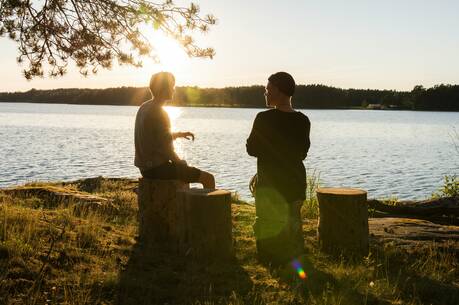What Happened?
If we who profess faith in the resurrection of the body were to visit a grave and find it open and the body gone, we would most likely assume that it had been taken. It is no wonder that Mary of Magdala, Peter and John drew the same conclusion when they arrived at Jesus’ tomb. Dead bodies don’t just get up and walk away.
Everyone is interested in “what happened” to the body of Jesus, but no biblical account tells us. All we know is that his followers found only an empty tomb, and some people claimed to have seen Jesus afterwards. Today’s readings refer to both of these. The Gospel focuses on the empty tomb; Peter’s speech in the first reading states that the risen Lord was visible to the disciples. These scriptural traditions are less interested in details of the Resurrection than in what it meant and continues to mean.
Peter traces the life of Jesus all the way to his death and resurrection. His purpose is to show that this man Jesus is “the one appointed by God as judge of the living and the dead.” He was God’s chosen one, the one through whom fulfillment would appear. If anyone claimed such an exalted position and died, the claim would most likely die with that person. But to make the claim, die and then rise from the dead gave legitimacy to the claim.
The very life and teaching of Jesus made such claims. Now that he was raised from the dead, those who witnessed his life were commissioned to give witness to his death and resurrection. We may not know what happened to Jesus, but we can see what happened to them. They fearlessly preached what initially they had not understood.
Paul’s teaching about the resurrection focuses on Christ’s exaltation at the right hand of God. Even here, he is less interested in how Jesus reached God’s right hand than in the implications of the Resurrection in the lives of Christians. Paul maintains that those who are joined to Christ die with Christ to this life, are raised with Christ to a life with God and will eventually share in the glory of Christ’s exaltation.
The order of today’s readings is liturgical rather than chronological. In other words, at first the followers of Jesus lacked understanding of what had happened, as recounted in today’s Gospel. Only later did preachers like Peter or Paul give testimony to their faith in the Resurrection. What changed them? Probably an experience of the risen Lord. This answer throws us back to the initial question: What happened?
Skeptics demand proof that Jesus rose from the dead. Today’s readings provide us with three places to look for such proof. The first is the fact that the tomb was empty. But this is questionable evidence, because the empty tomb simply means that the body of Jesus is gone, not that he has risen. The second piece of evidence is the post-Resurrection appearances. As proof, this is also rather weak, because the authenticity of mystical experience is very difficult to prove. Though questionable as proof, at least an empty tomb is something concrete. Though it may be even weaker evidence, a personal experience is real to the one experiencing it.
The third place to look for evidence of the Resurrection is the least concrete, but probably the most reliable. It is the quality of the lives of those who live out their faith in the Resurrection. We see it clearly in the transformation of Peter, who went from misunderstanding the Scriptures to interpreting them through the lens of the Resurrection. We see it in Paul who had set out to put Christians to death, only to become the champion of “dying and rising with Christ.”
We see “what happened” in the lives of countless women and men today who are examples of extraordinary integrity in the midst of deceit, of dedicated service in a world of selfishness, of patience and understanding in the face of violence, of forgiveness and reconciliation where there has been personal violation. Such lives are evidence that Jesus has risen from the dead and is alive in the world today.
So what are we to make of this wondrous day? How are we to understand the mystery it sets before us? This is the day on which we celebrate the fact of faith that Jesus was willing to die for us, but was not willing to stay dead. By rising he shattered the hold that death had over all of us. Death could not keep him down. And if we are joined to him, neither can it keep us down. We are “Easter people” when we put on new lives, not merely new clothes. By the grace of God, some day the power of Easter will so transform us that people will wonder about us too: What happened?
This article also appeared in print, under the headline “What Happened?,” in the April 5, 2004, issue.







